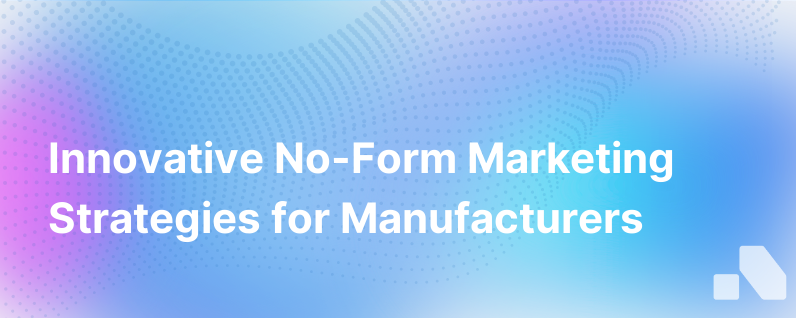No Form Marketing Strategy For Manufacturers
Published on October 10, 2023 by Sawyer Middeleer
In the competitive world of manufacturing, companies are persistently searching for innovative strategies to drive leads and sales. The traditional digital marketing funnel, which relies heavily on forms for lead generation, has long dominated the scene. However, there's a growing shift towards 'no form' marketing strategies in the manufacturing industry – approaches that allow potential customers to engage with brands without the initial barrier of form submissions. Here, we decode the concept of no form marketing and how it can revolutionize the way manufacturers generate interest and drive business.
Understanding No Form Marketing
No form marketing is a user-friendly approach that seeks to remove friction from the early stages of user interaction. Typically, online forms are used to gate content, requiring users to provide information like their name, email address, and company before they can access valuable resources such as whitepapers, e-books, or case studies. The no form approach, conversely, makes such resources freely accessible, fostering goodwill and trust from the outset.
Here's why moving beyond forms can be beneficial:
- User Experience (UX): With no barriers to access, potential customers enjoy a seamless UX which can lead to increased engagement and consumption of your content.
- Data Privacy: Today's users are increasingly wary of sharing personal information. No form marketing aligns with these privacy concerns, potentially increasing content reach.
- Lead Quality: When users are ready to reach out, they're often more qualified than those simply willing to exchange their contact info for a download.
Crafting a No Form Marketing Strategy
-
Leverage High-Value Content: Instead of gating, provide valuable content upfront. For example, share industry insights, trends, and case studies as freely available blog posts or videos. High-quality content will position your company as a thought leader and build trust with your audience.
-
Employ Progressive Profiling: Use analytics and behavior-based tracking tools to learn about your users over time. As they interact with your website and other marketing materials, you can gradually collect data on their interests and needs, tailoring your approach accordingly.
-
Focus on Relationship Building: Engage with leads through social media, webinars, and in-person events. Encourage interaction on social platforms by starting and participating in industry-relevant conversations.
-
Enhanced Website Experience: Optimize your site for user engagement. Implement chatbots that provide immediate assistance or use interactive tools like calculators or configurators that provide value without requiring forms.
-
Make The Most of Email Marketing: Instead of gaining subscribers through forms, encourage users to subscribe to newsletters or email updates through non-intrusive pop-ups or call-to-action (CTA) buttons.
-
Incentivize Referrals: Encourage current customers to refer others by offering discounts or special offers. Word-of-mouth can be more powerful than any form-based lead.
-
Rely on SEO: A strong SEO strategy ensures that prospects looking for solutions you offer can find you easily. Invest in optimizing your website's content for search engines.
Implementing a No Form Strategy
A shift to a no form strategy doesn't mean abandoning data collection; it means being smarter about it. Here are tips on how to implement this approach effectively:
- Content Library: Build a comprehensive library of resources on your website that is easily accessible. This can include technical specifications, catalogues, instructional videos, and more.
- Chatbots and AI: Integrate AI-driven chatbots that can guide users through your website and provide personalized assistance without a form.
- Social Media Engagement: Use platforms like LinkedIn to share content and engage in discussions, ensuring your brand stays top of mind.
- Retargeting and Advertising: Utilize retargeting ads to bring previous visitors back to your site, and use advertising to bring in new traffic.
- Email Nurturing: If you choose to have subscribers sign up for your email list, use this channel to provide consistent value, nurturing subscribers into leads with high-potential to close.
- Analytics: Use website and campaign analytics to gain insights into what content works well and who is engaging with it. You can still collect data; it's just less direct.
Benefits of a No Form Strategy for Manufacturers
- Brand Loyalty: By providing immediate value with no strings attached, you build brand equity and encourage loyalty from the start.
- Broader Reach: With content freely available, more users can discover and share it, extending your reach.
- Higher Quality Leads: When prospects do reach out, their interest is self-motivated, making them warmer leads.
- Quicker Sales Cycle: By accelerating the trust-building process and engaging with more knowledgeable prospects, the sales cycle can be shortened.
Measuring Success
To track the effectiveness of a no form marketing strategy, monitor metrics like content engagement, website traffic, time-on-page, social media interaction, email open rates, and direct inquiries. The increase in these metrics can provide a more nuanced understanding of customer interest and behavior than form submissions alone.
Conclusion
Adopting a no form marketing strategy can significantly benefit manufacturers by enhancing customer experience and fostering trust. By providing free value, encouraging user engagement, and strategically leveraging tools for progressive profiling, manufacturers can attract more qualified leads and cultivate deeper customer relationships.
This more open and user-centric approach aligns with modern digital usage patterns and data privacy preferences. In a world where manufacturing buyers are increasingly well-informed and independent in their research, a no form marketing strategy positions companies as facilitators of the buyer journey rather than gatekeepers. By implementing this strategy thoughtfully and leveraging the right digital tools, manufacturers can not only reach but also resonate with their ideal audience, driving meaningful engagement and, ultimately, sales.